Paul Gilster's Blog, page 228
April 8, 2013
TESS: A Full-Sky Exoplanet Survey
The news that NASA has approved the TESS mission kept my mood elevated all weekend. TESS (Transiting Exoplanet Survey Satellite) has been the logical NASA follow-up to Kepler ever since the Space Interferometry Mission was canceled in 2010. The point is that Kepler looks at a field of stars with the goal of developing a statistical analysis, helping us (ultimately) to home in on the value for ηEarth (Eta_Earth), the fraction of stars orbited by planets like the Earth.
To do this, Kepler is looking out along the Orion Arm of the galaxy, with almost all the stars in its field of view between 600 and 3000 light years away. In fact, fewer than one percent of Kepler’s 156,000 stars are closer than 600 light years. There are plenty of stars beyond 3000 light years, but as we push beyond this distance, the stars become too faint for Kepler’s transit methods to be effective. The carefully chosen field in Cygnus and Lyra is ideal for Kepler’s statistical data but the next question to ask is how many Earth-like planets are to be found around relatively nearby stars.
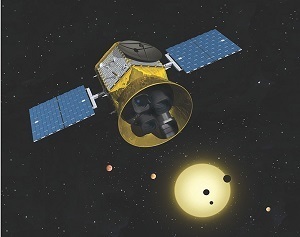
TESS is led by principal investigator George Ricker (MIT Kavli Institute for Astrophysics and Space Research), whose team will be working with an array of wide-field cameras to perform an all-sky survey, as opposed to the intense ‘stare’ Kepler makes at a particular starfield. Ricker says the mission should be able to identify thousands of new planets in the solar neighborhood in a survey that will cover 400 times as much sky as any previous exoplanet mission.
We all have ideal missions we’d like to see fly, from the Space Interferometry Mission to some sort of grandly designed Terrestrial Planet Finder, but among the realistic options in front of us, TESS makes abundant sense. It will home in on small rocky planets and help us measure their mass, density, size and orbit, along with offering up data on their atmospheres. And you can also think of TESS as something of a pointer scope for the James Webb Space Telescope and other future instruments that will begin the hunt for astrobiological signatures on other worlds.
Image: TESS’s primary goal would be to identify terrestrial planets orbiting nearby stars. Credit: MIT Kavli Institute for Astrophysics & Space Research.
“The TESS legacy,” says Ricker, “will be a catalog of the nearest and brightest main-sequence stars hosting transiting exoplanets, which will forever be the most favorable targets for detailed investigations.” That makes the $200 million funding for this bird money well spent. In an interview on the Kavli Foundation site, Ricker adds that the interactions of multiple planets as they orbit their host star, spotted through transit timing variations, can aid the search:
Measuring transit time variations is particularly important because if you find a large Neptune- or Saturn-sized planet that appears to be tugged a little bit, you can make an estimate of how massive the planet is that is actually doing the tugging. Measuring transit time variations, which is a technique enabled by Kepler data, is a bit like successively unnesting a Russian matryoshka doll – you go a few layers down and you can find smaller and smaller planets in the system. That’s one of the things that doing transit time variations, during the TESS mission, will enable us to do.
In other words, we’ll have TESS spotting planets around stars bright enough for ground-based telescopes to home in on these transit time variations (TTV), something we can’t readily do with most of the Kepler planets because their stars are too faint. The system is designed to detect changes in the intensity of a star’s light down to 40 parts per million. By comparison, Earth viewed from outside the Solar System would cause a transit drop of about 85 parts per million. Ricker estimates that TESS will be able to detect as many as 2700 planets, including several hundred Earth-size worlds. The TESS mission is now scheduled for launch in 2017.






April 5, 2013
Toward a Census of Earth-Sized Worlds
While transit and radial velocity methods get most of the press when it comes to finding exoplanets, gravitational microlensing offers an independent alternative. Here a star passes in front of a far more distant object, causing the light from the source to be gravitationally ‘bent’ by the intervening star. The useful thing for exoplanet work is that if the ‘lensing’ star is orbited by one or more planets, they can leave their own signature in the microlensing event. And indeed, microlensing collaborations like MOA (Microlensing Observations in Astrophysics) and OGLE (Optical Gravitational Lensing Experiment) have made the method pay off in exoplanet discoveries.
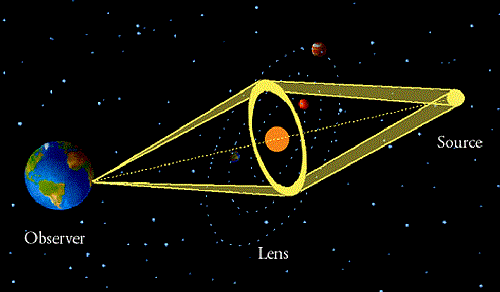
Image: Gravitational microlensing relies on chance line-ups between an intervening star with planetary system and a more distant light source. Credit: California Institute of Technology.
Now researchers at the University of Auckland are proposing to measure low-mass planets, planets as small as the Earth, using these methods. Microlensing events vary in terms of the degree of magnification they provide, with both MOA and OGLE finding some events with extremely high magnifications. You would think the higher the magnification, the better, but this turns out to be not necessarily the case, as the university’s Phil Yock and colleagues explain in a new paper. Their simulations clarify the methods we can use to detect Earth-sized planets:
Our conclusion is that low-mass planets can be efficiently searched for in events with moderately high magnifications of order 50-200, and that the greater frequency of these events in comparison to those with higher magnifications lends advantage to monitoring them. However, to take full advantage of their discovery potential, telescopes with apertures in the range 1-2m would be needed to photometer them with sufficient precision to detect low-mass planets.
A network like this is, in fact, being deployed by the Las Cumbres Observatory Global Telescope Network, working in collaboration with SUPA/St Andrews (Scottish Universities Physics Alliance). These are 1- and 2-meter instruments, with three telescopes each in Chile, Australia and South Africa, and one each in Hawaii and Texas. Working with a telescope in the Canary Islands and supplementing its data with several other southern hemisphere instruments, the network, according to Yock and colleagues, ought to be able to help us not only detect Earth-sized planets but measure them at substantial distances from their star. Says Yock:
“Our proposal is to measure the number of Earth-mass planets orbiting stars at distances typically twice the Sun-Earth distance. Our planets will therefore be cooler than the Earth. By interpolating between the Kepler and MOA results, we should get a good estimate of the number of Earth-like, habitable planets in the Galaxy. We anticipate a number in the order of 100 billion.”
It’s an intriguing idea. The Kepler effort is all about developing a statistical read on how often Earth-class planets occur in the galaxy by looking at a huge number of stars. Yock’s work demonstrates that low-mass planets can come out of microlensing observations through continuous network monitoring. The paper notes that in recent times, about 10 events with magnifications over 200 have been detected by MOA and OGLE every year. Dropping the magnification requirement to 50 should quadruple the detection rate, allowing us to develop an independent check on measurements made by radial velocity and transit studies.
Consider how useful microlensing can be. We are not burdened, as with radial velocity and transits, with a measurement more sensitive to larger worlds closer to their host stars. The planets thus far detected through microlensing have had masses ranging from a few Earth masses to a few Jupiter masses, while their separation from their hosts has been on the order of several AU. This provides, says the paper, ‘a representative sample of the distribution of planets between us and the centre of the Galaxy that orbit a relatively unbiased sample of host stars.’
Thus we can supplement other ways of estimating the abundance of cool planets in the Milky Way by developing a statistically significant sample of detections through the kind of microlensing events Yock describes. The paper is Abe et al., “Extending the Planetary Mass Function to Earth Mass by Microlensing at Moderately High Magnification,” accepted for publication at Monthly Notices of the Royal Astronomical Society (preprint). More in this RAS news release.






April 3, 2013
Clarke: The Rocket Man Emerges
In the 1950s, Arthur C. Clarke’s fame had begun to spread, and he sometimes referred to himself, genially enough, as an ‘unemployed prophet.’ This is a period in Clarke’s career that, from 1953 to 1956, saw the emergence of the fifteen tall tales that would be published in 1957 as Tales from the White Hart, a fictitious pub modeled after London’s White Horse. But while the stories were extravagant, the setting was the perfect amalgam of Clarke’s interest, for the White Horse was where science fiction met rocketry for his extensive network of friends.
One habitué of the White Horse was Ken Slater, whose recollection of those meetings appears in Neil McAleer’s Visionary: The Odyssey of Sir Arthur C. Clarke (2013):
“Anybody new that came to the pub was always told to ask Arthur to tell them about rockets, you see. Which they would do and then sit back for the short lecture. After Arthur broke into the short lecture, then we’d always strongly advise the newcomer to ask, ‘Look, what does the rocket push against?’ Which immediately brought forth from Arthur the long lecture, you know, the five-guinea version. That was a standard put-on at the White Horse, because if you ever got Arthur on rocketry, you could sit back and let the bar listen for up to a couple of hours.”
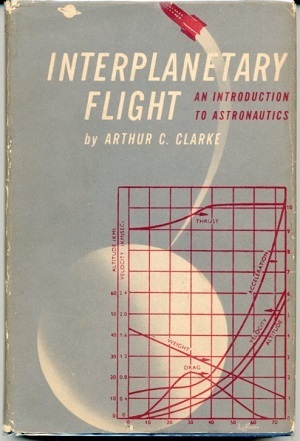
By now Clarke was well established in science fiction, with credits like The Sands of Mars (1951) and Childhood’s End (1953), along with short story collections like 1953’s Expedition to Earth. But as McAleer notes, it was science writing rather than science fiction that had made him realize it was time to become a full-time writer. The spur was a contract with Temple Press in 1949 for a nonfiction book called Interplanetary Flight, which drew heavily on a two-part paper he had published in separate magazines in previous years. The book presented spaceflight for the general reader, though the more technical minded could find Clarke’s equations tucked neatly away in the appendix.
The Science Writing Breakthrough
Now emerges Clarke the educator, a rocket scientist with a bent for philosophy who saw the exploration of space as both a physical and a spiritual quest. Carl Sagan would call Interplanetary Flight ‘a turning point in my scientific development,’ and technology in service of the human spirit became Clarke’s idée fixe, the principle that would hold humanity together by offering it challenges that summoned up all its reserves of intellect and courage. Soon Clarke’s American editor George Jones would encourage him to write 1952’s The Exploration of Space, which was bought by the Book of the Month Club.
Clifton Fadiman, for years one of the BOMC’s judges, met Clarke on the first of the author’s trips to the United States. McAleer quotes him on a meeting at the Plaza Hotel:
“The Oak Room is a rather worldly rendezvous. Mr. Clarke is not worldly; he is otherworldly. He spoke of space satellites, lunar voyages, interplanetary cruises, as other men would discuss the market or the weather. As he explained how within a decade three space stations whirling in an orbit about the equator will make possible (indeed one fears inevitable) simultaneous world-wide television broadcasting, our right-hand neighbor (a vice-president of CBS) went into a kind of catalepsy.
“To understand a mind like Mr. Clarke’s we must realize that during the last fifty years, more especially the last twenty-five years, virtually a new mental species has emerged among us. They are the men who in a real sense live in the future, men for whom the present is merely a convenient springboard.”
If you’ll go back to the first of these articles on Clarke (The Vision of Arthur C. Clarke), you’ll see in the second photo there that Clarke is wearing under his jacket a T-shirt that Gregory Benford gave him. The text is barely readable, but if you look closely, you’ll see that it says “I invented the communications satellite, and all I got for it was this lousy T-shirt.” Fadiman remembers Clarke’s enthusiasm for the idea in 1952, but it would indeed make him little money.
As his stint in the Royal Air Force drew to a close in 1945, Clarke developed the notion of geostationary satellites providing global communications. During the war he had worked on microwaves and radar, while his passion for rocketry provided the means of deployment. McAleer points to George O. Smith as a possible influence, the latter having published a series of stories in Astounding during the war years that became known as the Venus Equilateral series. Clarke even wrote an introduction to a 1976 reprint of these stories saying that they might well have influenced him subconsciously in his work.
The article “Extra-Terrestrial Relays,” whatever its sources, would appear in Wireless World in October of 1945. Worldwide coverage by radio and television would be implemented by a series of spacecraft with an orbital period of 24 hours at a distance of 42,000 kilometers from Earth center. Clarke went on to describe the equatorial orbits that would place space stations into ‘fixed’ spots in the sky (as seen by people on Earth). The predictions were bold, valid and, yes, visionary, but remained unheralded at the time except by the US Navy. Many believe the article was influential in the development of early space satellites.
Clarke’s $40 from Wireless World offered him plenty of opportunity later in life to joke about the real monetary value of the communications satellite concept, and McAleer notes that he never showed any regrets about what might have been. In any case, being a visionary was already becoming a habit for the writer, one that seemed to outweigh financial considerations. While still in the RAF and working as an instructor at a radio school in Wiltshire, Clarke often broke into soliloquies on rocket science, describing at one late night session how multistage rockets would get us to the Moon. When asked how big the rocket would be, he described it as the height of St. Paul’s Cathedral, which turns out to be within a few feet of the height of the Saturn V.
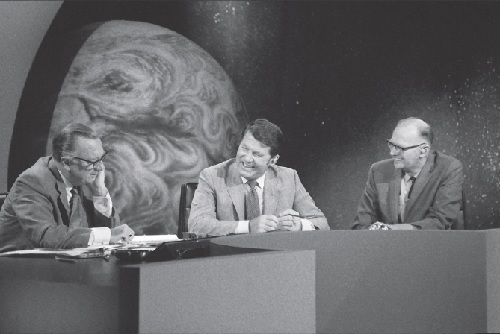
Image: With Walter Cronkite (L) and Wally Schirra (center), Arthur C. Clarke takes part in CBS coverage of Apollo 11’s return to Earth on July 24, 1969. Credit: CBS:Landov.
The Pleasures of Re-Reading
The twin themes of Clarke’s life — the future as depicted in science fiction and the technology that would get us there — were fully in place by 1950. For the rest, for Sri Lanka and 2001 and the space elevator, for the increasing fascination with the ocean and diving expeditions among the Pacific coral, for the Apollo coverage with Cronkite and the extraterrestrial interloper called Rama, I send you to McAleer’s book. But I also send you emphatically back to Clarke himself. I’d begin a re-read of the man with his short stories, probably starting with Expedition to Earth and moving then to Childhood’s End. I’d look anew at The City and the Stars and them make a point of picking up The Songs of Distant Earth, a few thoughts on which will close this piece.
The Songs of Distant Earth came out of Clarke’s speculations on using an interstellar rather than an interplanetary setting, and the genesis of the book was a short story written in 1957, the year of Sputnik. Thirty years later he would begin the novel of the same name, one he would always consider his best work. Clarke took his crew to a planet 50 light years away, traveling in hibernation at ten percent of the speed of light. Judy-Lynn del Rey would publish the book in 1987, a hard science fiction tale that at its kernel contained a love story. McAleer says this:
Thematically, as in much of Clarke’s fiction, the novel addressed humanity’s quest for purpose and immortality in contrast to the individual’s inevitable death. The loneliness of man is intensified against the backdrop of cosmic space and the finiteness of human time. Even if the survival of Homo sapiens is assured through interstellar travel, are not individuals doomed even as they embrace in love and light to keep the fall of night at bay? Clarke’s “songs” are not as joyous and uplifting as we might first expect. Always present in the novel is the feeling of insurmountable separation across the voids of space, time, and death.
Clarke tried to pull out all the stops here — he was sensitive to the charge of flat characterization and wanted to counter it, and The Songs of Distant Earth demonstrates he had it in his power to do that, though reading the book I can sense how hard the effort must have been. For Clarke’s characters are, for the most part, drawn to serve a plot purpose, and in the bulk of his fiction, we see character used the way the writer and critic James Gunn thinks it should be used in science fiction, as a way of creating a representative humanity in which the important work — the ideas of the tale — can be made manifest by the character’s reaction to them.
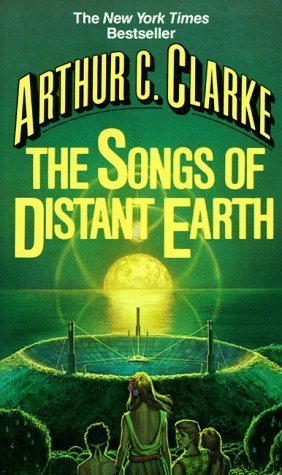
That can still make for powerful fiction, but you can see from the characters in The City and the Stars that their very flatness of affect is the result of their situation, living a changeless life in the eternal city. Or think of Keir Dullea and Gary Lockwood in 2001: A Space Odyssey, where the difference between humans and their technology is not always apparent, the crew of Discovery sometimes seeming as robotic as Hal himself.
None of this matters when, as did Stapledon, Clarke takes our imagination into the deep future and rotates our view back around to see what our world looks like from that perspective. He was dismissive of the idea that science fiction is nothing but escapism, telling Alice Turner:
“It’s hard to define science fiction these days, especially since the mainstream seems to be moving in that direction. Traditionally, it’s been a form that offered a good story, and I suppose you could call that escapism, in a positive sense. C.S. Lewis, who wrote it himself, said, ‘The only people who think there’s something wrong with escapism are jailers.’”
But I also like what he told Alan Watts: “The purpose of the universe, Alan, is the perpetual astonishment of mankind.” Clarke was a writer who thought not in terms of years but of aeons, and not so much of individual humans as of the species. Re-reading Clarke, then, should also take us to his collected non-fiction, the hefty volume called Greetings! Carbon-Based Bipeds (1999). Here the twin strands of Clarke’s work come together, a lifetime of enthusiasm for and optimism about technology and the deep spaces to which it can take us all.
Addendum: The Rosetta Books ebook edition of Visionary, Neil McAleer’s revised biography of Arthur C. Clarke, is now available through Amazon.






April 2, 2013
Arthur C. Clarke: On Cities and Stars
I’ve always wondered how Arthur C. Clarke coped with the news he received in 1986, when doctors in London told him he was suffering from amyotrophic lateral sclerosis, a terminal illness that in the States is often called Lou Gehrig’s disease. The diagnosis was mistaken — it turns out Clarke actually suffered from what is known as ‘post-polio syndrome,’ a debilitating but not fatal condition. For two long years, though, he must have thought through all the symptoms of ALS, knowing that the degenerative motor neuron breakdown could gradually sap him of strength and movement. How would such an energetic man cope with an agonizing, slow fade?
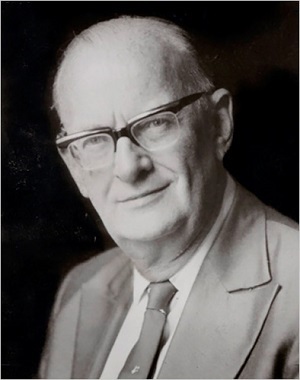
Neil McAleer’s revised biography (Visionary: The Odyssey of Sir Arthur C. Clarke) gives the answer, as recounted by Clarke’s brother Fred:
“…after the initial shock, Arthur more or less said, damn it, he’d got an enormous amount he wanted to do, and if he’s only got fifteen months to do it, he’d better whack into it. And he did whack into it, and the next year he produced four books.
“Eighteen months later he was still writing, and all the horrible things they told him might happen hadn’t happened to him. Of course they had told him all the things he should do to keep it under control—what diets to take and what exercises to do, which he very religiously did. He carried on working intensely and produced an enormous amount of work, which might have been the saving grace. If he had been the sort to say, ‘Oh my God, I’m going to die in fifteen months,’ he probably would have…”
That story speaks volumes about the man, identifying a resolve that kept him working despite his other ailments into his nineties. It also tells me that he was able to place himself mentally in a context that weighed a single human life against the broad movement of history. I think Clarke was happy to see himself as someone who instigated currents of thought, changed perspectives and launched careers. He did these things for people of all ages both by the example of his own life and by the lives he created in fiction that showed us what humanity might become.
Young Writer at Work
By the time Clarke moved from Somerset to London in 1936 he was already suffused with science fiction and in particular enraptured with Olaf Stapledon’s Last and First Men, not to mention the second-hand copies of American science fiction magazines that were then available in England. He spoke of the ‘ravenous addiction’ these magazines inspired and the effect that Stapledon’s novel, with a time scale spanning five billion years, had upon his imagination. He was twelve years old when he first read Last and First Men, awed by its cosmic reach and its placement of the evolution of humanity against the broader backdrop of the cosmos.
Think for a moment of 2001: A Space Odyssey. Has any film ever covered a wider swath of time, from the beginnings of tool making to the apotheosis of the species in an extraterrestrial encounter? This was Clarke’s stage, but the other great discovery of his youth, David Lasser’s The Conquest of Space (1931) gave him the technology he would spend a life examining. Lasser was the founder of the American Interplanetary Society (which became the American Rocket Society and, eventually, the American Institute of Aeronautics and Astronautics). He was also, for a time, the editor of Hugo Gernsback’s Science Wonder Stories and Air Wonder Stories. If Stapledon brought Clarke the cosmos, Lasser gave the boy a focus on the attainable, the idea of space as a reachable frontier.
In London, Clarke had a tiny flat in Norfolk Square and was soon co-editing (with science fiction writer William Temple) the fanzine Novae Terrae, whose editorial sessions were so cramped in Clarke’s quarters that Temple once said “…there was hardly room for the two of us, and A[rthur]’s Ego had to be left outside on the landing.” Clarke’s nickname of Ego derives from this period when Temple and Clarke both discovered the latter’s competitive nature. I think McAleer is right in stressing, though, that Clarke’s volubility was largely the result of his enthusiasms. This was a man who loved, above all else, the communication of an idea.
Into the Remote Future
For those keeping score, Novae Terrae would soon become, under the editorship of Ted Carnell, the influential magazine New Worlds. But in the days just before World War II, while working on issues of Novae Terrae and assorted publications for the British Interplanetary Society, Clarke found time to begin developing his first novel from ideas that had come to him back in Somerset. “Against the Fall of Night” would appear in an early version in Startling Stories in November of 1948, but that hardly ended the tale. Clarke kept rewriting the story, seeing it into print as a novel from Gnome Press in 1953 and then putting it through a major revision as The City and the Stars, published in 1956.
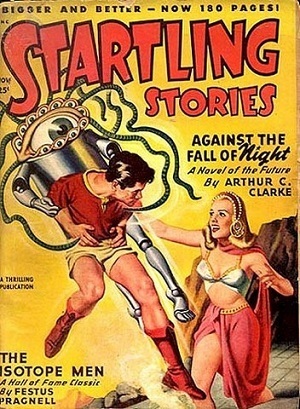
I seldom think of Clarke as a reader of poetry, but he clearly knew his Housman:
Here, on the level sand,
Between the sea and land,
What shall I build or write
Against the fall of night?
The words are from Housman’s poem “Smooth Between Sea and Land.” Maybe the idea of long stretches of sand and a metaphorical night that comes to us all fired his imagination. I came across The City and the Stars just a few years after it was published and was mesmerized by its setting in much the way Clarke was taken with Stapledon’s Last and First Men. Here was Diaspar, the city of the far future, the only city on planet Earth, whose inhabitants moved through a high-tech monument to stasis. Nothing changes in Diaspar even as the world around it loses its oceans and becomes desert. Clarke would have much to say about the kind of inward thinking that his characters have to overcome, but the unmistakable fact about Diaspar is that the city at the end of time is also achingly, eerily beautiful.
Here’s science fiction writer Jo Walton on the book, nailing its essential allure:
The plot is quite simple. Diaspar is beautiful but entirely inward turned. Alvin looks out and discovers that there is more in the universe than his one city. He recovers the truth about human history, and rather than wrecking what is left of human civilization, revitalises it. By the end of the novel, Man, Diaspar, and Earth have begun to turn outward again. That’s all well and good. What’s always stayed with me is the in-turned Diaspar and the sense of deep time. That’s what’s memorable, and cool, and influential. Clarke recognized though that there isn’t, and can’t be, any story there, beyond that amazing image. It’s a short book even so, 159 pages and not a wasted word.
As to its author, I love the way he could never let this book go. It was, after all, his first novel, and as such it was perhaps the most deeply inspired by the reading of his youth. When he wrote a new preface to it in 1955, he noted that developments in information theory encouraged him to re-think the future course of humanity, a revision that would lead, says McAleer, to a whopping seventy-five percent new prose. The man was indefatigable; he couldn’t let go when ideas seized him, and when he had the wind behind him, no horizon was too far to strive for.
Restless Thoughts from Orbit
On the same visit to the United States in which he met Neil McAleer and learned that he did not have ALS after all, Clarke visited the National Air and Space Museum with Gregory Benford, long-term colleague Fred Durant and Hector Ekanayake, whose friendship with Clarke in Sri Lanka spanned decades. Benford noted the lack of long-term perspective in much contemporary science fiction and pointed out that The City and the Stars had been written before the discovery of DNA, so biology made no significant appearance in the story. Benford and Clarke’s Beyond the Fall of Night (1990) would be the result of that conversation.
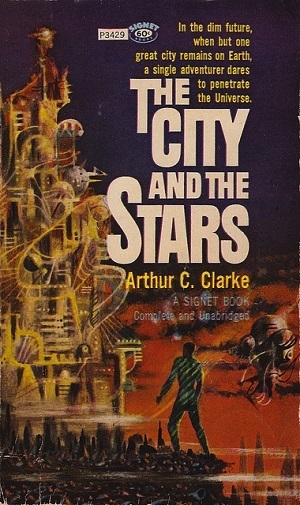
McAleer’s biography gives the details on all of Clarke’s books, but my childhood fascination with The City and the Stars has kept me focused on the early stages of Clarke’s career in London and the ideas that began germinating both there and earlier in Somerset. The Signet paperback illustrated here is not the edition I first encountered, but I have to run it because of my love of Richard Powers, whose cover art appeared in so many paperbacks from this period. In this case, Powers’ surreal images go far toward capturing the timeless allure of the city in the desert.
The letters that McAleer has access to offer insights from Clarke’s old associates, and some new ones as well. In 2006 a British engineer named Nicholas Patrick was about to fly on a Space Shuttle mission, Discovery STS-116. He wrote Clarke to invite him to the launch, telling him he had been reading Clarke’s books since growing up in London. Due to his health problems, Clarke was unable to appear, though he wrote an enthusiastic response thanking Patrick, who replied:
“I am sad to hear that you will not be able to attend the launch, but understand completely given the circumstances. Perhaps instead, if you are willing, I might email you from orbit. “A month ago I reread The City and the Stars, perhaps my favourite book, and was again drawn by the ideas in it. Ever since I first read it, I have wanted to find an old spaceship and travel to distant suns. I shall be very happy in low earth orbit, but I don’t think it will completely satisfy me.”
And that’s the thing: Anyone who has grown up with The City and the Stars is going to find even the wonders of Earth orbit a bit tame. Clarke was always at his best as a science fiction writer when taking the long view. His characters would learn to burst free from Diaspar, but its very conception is as staggering and poetic as anything he ever wrote. From the book:
Here was the end of an evolution almost as long as Man’s. Its beginnings were lost in the mists of the Dawn Ages, when humanity had first learned the use of power and sent its noisy engines clanking about the world. Steam, water, wind-all had been harnessed for a little while and then abandoned. For centuries the energy of matter had run the world until it too had been superseded, and with each change the old machines were forgotten and new ones took their place. Very slowly, over thousands of years, the ideal of the perfect machine was approached – that ideal which had once been a dream, then a distant prospect, and at last reality: No machine may contain any moving parts. Here was the ultimate expression of that ideal. Its achievement had taken Man perhaps a hundred million years, and in the moment of his triumph he had turned his back upon the machine forever. It had reached finality, and thenceforth could sustain itself eternally while serving him.
Thus Clarke’s description of the computer that runs Diaspar free from all human intervention. What continues to confound me about Clarke is what McAleer brings out so well, the duality between an imagination capable of transcending time and the canny engineering horse-sense that spawned near-term space achievements. This is the man who dreamed up communications satellites when not dreaming of eternal cities of the far future. Tomorrow, then, let’s look at Clarke the space pioneer.






April 1, 2013
The Vision of Arthur C. Clarke
In a 1955 letter to the British rocket scientist Val Cleaver, Arthur Clarke wrote about his view from the island then called Ceylon:
“Beautiful night last night. Southern Cross (a very feeble constellation) just above the front gate, with Alpha Centauri beside it. It always gives me an odd feeling to look at Alpha and to realize that’s the next stop.”
The next stop indeed. Cleaver was a fellow member of the British Interplanetary Society who, like Clarke, was instrumental in energizing the society after World War II. Both men served the BIS as its chairman in those years, and after Cleaver’s wartime work at De Havilland, he would go on to start a rocket division for the company and become chief engineer for the rocket division of Rolls-Royce. He is perhaps best known as the man behind the Blue Streak missile, but for those with a passion for the works of Arthur C. Clarke, he will always be remembered for his deep friendship with the man, and his energetic contribution to British thinking on space travel.
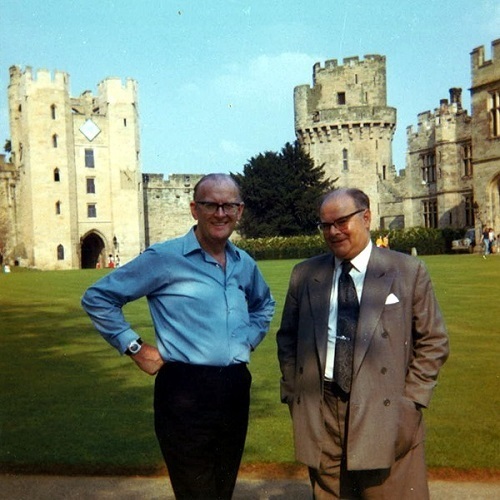
Image: Arthur C. Clarke and Val Cleaver at Warwick Castle in August of 1973. Credit: British Interplanetary Society.
Neil McAleer’s new book on Clarke is called Visionary: The Odyssey of Sir Arthur C. Clarke (Clarke Project, 2012). It’s the place to go for the background on this period, and on any period, in Clarke’s life. I call the book ‘new,’ but it’s actually a major revision and update of McAleer’s 1993 biography that adds extensive coverage of Clarke’s last fifteen years, covering a lot of material that was new to me, including insights into Clarke’s synergistic relationship with Stanley Kubrick, his reaction to the tsunami of 2004, and the almost playful way he fielded questions about his private life until a newspaper scandal based on nothing more than innuendo delayed the ceremony conferring his knighthood for two years. Throughout, McAleer’s research is exhaustive, drawing on memoirs, interviews and letters from Clarke’s many friends.
I have no hesitation in pointing you to this book if, like me, you were influenced by Clarke in your thinking about the human future in space. McAleer, an accomplished author of both fiction and non-fiction about spaceflight, met Clarke for the first time in the summer of 1988, when the latter had just been released from Johns Hopkins after a period of medical tests. The 70-year old Clarke, by then renowned for his science fiction but equally for his contributions to spaceflight including the development of the communications satellite, had been diagnosed several years earlier with amyotropic lateral sclerois (ALS), a terminal illness also known as Lou Gehrig’s Disease.
Because the doctors found the diagnosis had been mistaken, we can assume that McAleer met Clarke at a propitious time, and he proved more than willing to let the younger writer begin a biography, armed with a contact list of 200 names that Clarke gave him. The final, revised biography is now available in several editions ranging from a beautifully crafted signed and numbered hardback, a limited edition paperback, and a soon to be available e-book edition from Rosetta Books. I think Clarke would appreciate the transition to electronic books and would find the idea of reading his work on a Kindle as natural as doing telecommunications from Sri Lanka.
Back in 2007 I published Gregory Benford’s two-part travelogue about his journey to Asia, part of which involved flying to Sri Lanka, Clarke’s adopted home, from which Clarke routinely addressed audiences throughout the world as he continued to battle post-polio syndrome. The visit would have occurred a scant year before Clarke’s death. Here is how Benford described him:
Arthur has post polio syndrome and thus very little memory or energy. He turns 90 this December and wants to keep in touch with the outer world, mostly through the Internet. He has few friends left in Colombo. He took us to the Colombo Swimming Club for lunch, a sunny ocean spot left over from the Raj. It felt somehow right to watch the Indian Ocean curl in, foaming on the rocks, to the tune of gin and tonics — and to speak of space, that last, greatest ocean. Science fiction is to technology as romance novels are to marriage: a sales pitch. But without vision and then persuasion, little would ever happen. Arthur has always known that.
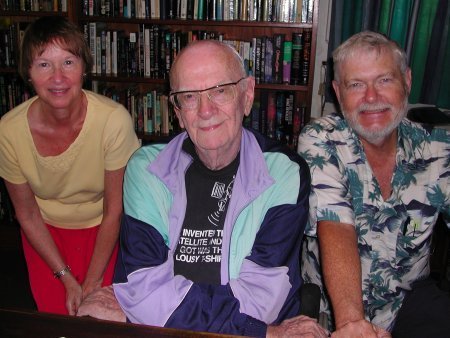
Image: Elisabeth Malartre, Arthur C. Clarke and Gregory Benford.
Vision and then persuasion — how better to describe how Arthur Clarke operated throughout a lifetime that lasted longer, as McAleer points out, than it takes Halley’s Comet to orbit the Sun? His outlook was always positive and framed in knowledge of humanity’s possibilities when enriched with technology. But he was also believer in the deep context of time and that takes me back to McAleer’s hardcover edition for a moment. Like Clarke, McAleer is a believer in long-term thinking and the symbolic acts that link us with the generations that follow us. Thus he designed the hardcover edition to last, as noted in the comments at the beginning of the book:
The challenge was to create a physical book that might survive perhaps half a millennium. With that goal in mind, the biographer researched the use of preservation-quality materials in its production—paper, ink, binding, casing, Smyth-sewn signatures and silver die stamps evoking the stars… The author intends—although he may not be able to guarantee!—that this edition’s pages will last 500 years, even outside environmentally controlled rare-archive repositories. As such, it’s hoped that this artifact will carry the artistry of Gutenberg into a future when new physical books may be far fewer.
What better tribute to a man who, in Jo Walton’s memorable phrase, wrote so eloquently about ‘the poetry of deep time’? The book that exemplified that poetry was The City and the Stars, a work that elicits so many reactions in me that I want to discuss it with reference to McAleer’s book at greater length than I have time for today. The frustration of trying to write about a man whose contributions infused both the science and literature of his time is that he was almost too big for the page to hold him. I’m going to need several days with Clarke and McAleer, continuing tomorrow with the tale first known as Against the Fall of Night.






March 29, 2013
A Starship Report from Brussels
Tau Zero’s founding architect brings news of a recent European Union meeting that included starships and their implications on the agenda. Here’s hoping that while he was there he also had the chance to sample some of those fabulous Belgian ales…
by Marc Millis

The European Union recently held a conference to collect information to plan for the coming decades of science and technology priorities. This included the theme of international collaboration and the implications for all humanity across the globe. As a part of this conference, the EU organizers invited Mae Jemison of the 100 Year Starship organization to chair a session about interstellar flight. Mae rounded up a suite of speakers including Buzz Aldrin (a genuine space celebrity), Jill Tarter (SETI), Lou Friedman (solar sail advocate and former Planetary Society director), Kathryn Denning (space anthropologist), Pam Contag (microbiologist), Marc Millis (propulsion physicist), and about half-dozen more.
Image: Outside the European Parliament building in Brussels. Credit: Marc Millis.
The presentations were recorded and can be accessed here either now or very shortly. Look for the link to 100 Year Starship Session at European Parliament 2013. There were 11 talks of roughly 4 minutes each, plus Q&A. The talks covered a healthy span of issues and approaches. This coverage included the motivations for star flight, the compelling reasons to begin now, the search for extraterrestrial intelligence, the degree of difficulty involved in achieving true star flight, and a variety of insights regarding the imperative to create sustainable closed loop life support.

The topic of sustainable life support was given a healthy dose of attention. For human star flight, this is an unavoidable imperative whose methods must achieve 100% recycling. This forces achievements beyond what is necessary for Moon and Mars bases. In addition to the obvious issues of sustainable biology and human physical health, issues such as clothing manufacturing and recycling, governance methods, and questions about what cultures and individual life experiences would be fitting for an interstellar world ship emerged in these discussions.
Image: Buzz Aldrin addresses the guests during a dinner session. Credit: Ronke Olabisi.
While some might think that issues like these can be postponed until we are closer to the goal, remember that all humanity is trapped on a spaceship with a malfunctioning life-support system (human-induced climate change) right now, along with a radiation shielding system whose permanence is not guaranteed and a ‘crew’ that is largely oblivious to their responsibility for maintaining the habitability of spaceship Earth.
But all is not dark despite such gloomy prospects. There were also plenty of discussions about using the goal of star flight to provide a positive view of the future, something to allow us all to thrive, not just survive. For example, one talk suggested that we use the context of the love for our children to frame this positive future view. It was interesting that the person who made this comment, Jennie Yeung, also made the observation that she was the only Asian in this interstellar session and that Asians represent roughly half of the population of starship Earth.
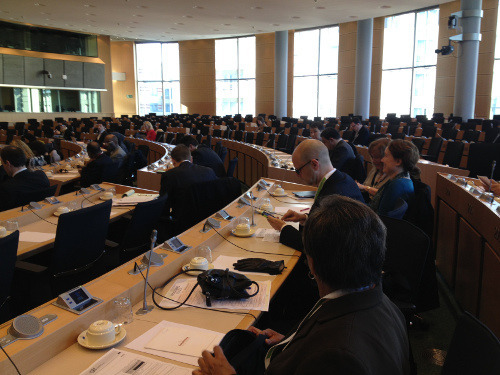
Image: The European Union session at work. Credit: Marc Millis.
Sustaining Spaceship Earth, and learning how to create more world ships, calls for a world-wide endeavor. The focus of subsequent discussions was, “What do we do next?” Recall that at our present rate of procrastination, two-centuries remain before starflight might become possible (not including precursor missions). What is not known is if human society will survive long enough to achieve that sustained survival ability. Amongst the speakers, deep thinkers in their own right, there was frank discussion about such unknowns and what we can each do to make a better future. While Mae Jemison assembles a proposal to the European Union for interstellar work, the individual speakers discussed amongst themselves how to collaborate and what we can each do as we pursue our own specialties to make relevant progress. Despite the encouraging invitation from the European Union that puts the focus on these possibilities, there is no guarantee that there will be funding for this type of work.
The effect of star flight on society was also discussed. First, when considering the levels of energy needed to achieve interstellar flight, our civilization will have had to have achieved sustainable peace amongst ourselves. Even a slight misuse of these levels of energy could destroy the entire surface of Earth. Humanity must mature to have the responsibility to use such prowess safely.
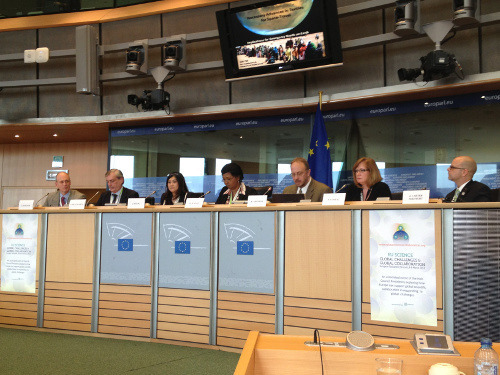
Image: Speakers’ stations at the meeting. Credit: Marc Millis.
John Carter McKnight, Kathryn Denning, and others articulated the dimensions of the ethics and regulatory issues involved in moving towards interstellar capabilities. And when it comes to how to tell the story of the values and risks of interstellar flight, Kathryn Denning suggested that we avoid using some common analogies that have been popularized to discuss spaceflight. Specifically she cautioned against analogies to Columbus and Magellan, since these events of discovery also included some of the uglier sides of humanity, such as greed, mutiny, and slavery. In short we need to create a new positive message that accurately conveys the opportunities risks and sensible steps to eventually achieve both the societal maturity and technological capability of star flight, and in so doing, vastly improve life on Earth.
In the meanwhile then, while we all wait for our ideal levels of funding to come in, we shall continue ad astra incrementis, to the stars in ever-increasing steps.
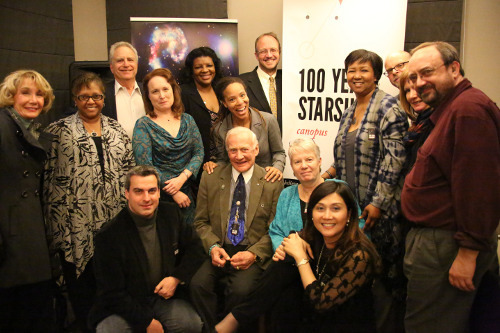
Image: A group shot following discussions on the 100 Year Starship project in Brussels. The front four: Marsal Gifra, Buzz Aldrin, Jill Tarter, Jennie Yeung. In back curving from left to right, Kathleen Colgan, Gwen R. Artis, Lou Friedman, Kathryn Denning, Alires Alimon, Ronke Olabisi, Karl Aspelund, Mae Jemison, John Carter McKnight, Pam Contag, Marc Millis. Credit: Ronke Olabisi.






March 28, 2013
Into the Orion Arm
Although we have little observational data to go on, the existence of the Oort Cloud simply makes sense. We see new comets coming into the inner system that are breaking up as they approach the Sun, obviously not candidates for long survival. There has to be a source containing billions of comets to account for those we do see. The Kuiper Belt is stuffed with what we can call ‘iceteroids,’ all moving more or less along the plane of the ecliptic until, well beyond the Kuiper Belt itself at about 10,000 AU, the disk shaped belt of material spreads into the spherical Oort Cloud. A nudge from a rogue planet or passing star is enough to produce the velocity change to send a comet inward.
We’ve been looking this week at possible human uses for cometary objects, including the fact that they’re rich in water but also nitrogen and carbon wrapped up in interesting organic compounds. From the standpoint of resource extraction, we also find interesting elements like silicon, sulfur, nickel, chromium, magnesium and iron available in at least small amounts. Tiny worlds a few kilometers in diameter, rich in resources and loaded with water, existing by the trillions. Surely a space-oriented civilization of the future will find a way to exploit them.
Protecting the Inner System
But it’s likely that long before we start talking about a human presence in the Oort Cloud, we’ll be engaged in robotic studies driven by the sheer necessity of protection. Recent near-miss asteroid events have raised public consciousness about near-Earth objects that could pose a threat to our planet. Comets can wreak havoc as well, with the difference that near-Earth objects are gradually becoming tracked and catalogued. With an NEO, we can plot trajectories that give us time to consider how to move an object that might not be projected to hit for decades.
Comets are different. We can’t predict when a new one is going to appear. Robert Zubrin points out that when the huge comet Hale-Bopp was detected in 1995, it was well beyond the orbit of Saturn, but moving at a speed sufficient to cross the Earth’s orbit a mere two years later. An object like this, massive and moving at high velocity, would have been all but impossible to deflect if we had learned it was headed for us. Deflecting a fast-moving comet, as opposed to a nearby asteroid, means getting to it when it is still deep in the outer system. Planetary protection will all but ensure we’ll have a presence in the Kuiper Belt and Oort Cloud one day.
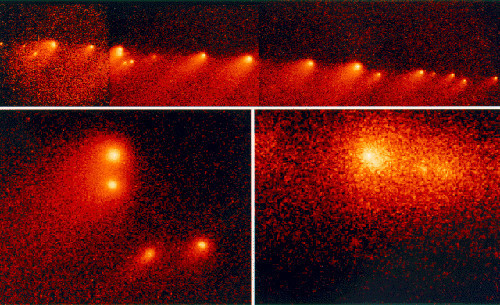
Image: Comet Shoemaker-Levy 9, torn into pieces as a result of a close approach to Jupiter in July 1992, before its later impact with that planet. The major cometary fragments range in size from one to a few kilometers. Credit: JPL.
Whether such a presence is largely robotic or not, it will spur the technologies we’ll eventually use for starflight. And not just the technologies — as we’ve seen, human settlements on O’Neill cylinders exploiting cometary resources would be case studies in isolation and social experimentation. Starships designed for fast crossings (multiple decades) or gradual voyaging (thousands of years) will have to incorporate what we’ve learned about people working together to keep communities in coherence when far from home. The Oort Cloud has a role to play.
The Fork in Interstellar Evolution
It’s possible that we may see two kinds of starflight in the next thousand years. I turn again to Richard Terra, whose article “Islands in the Sky” ran in the June, 1991 issue of Analog (it’s also reprinted in a 1996 hardcover from Wiley with the same name, a volume of essays edited by Stanley Schmidt and Robert Zubrin). Terra’s notion is that the wealthy inner system cultures will eventually develop what Ben Finney calls ‘fastships,’ spacecraft capable of moving at a substantial percentage of the speed of light. These will always be the first to cross the interstellar divide, but a slower wave of migration will follow.
The point is this: A small but growing human population in the Oort Cloud will master cometary motion, taking advantage of the fact that at 10,000 AU, the speed needed to orbit the Sun is just 300 meters per second. Compare this to the Earth’s 30,000 meters per second and it should be obvious that it takes only a small change in velocity to alter a comet’s orbit. We’ll have learned this in theory if not in practice because it factors into the engineering needed to divert a potentially dangerous comet from striking our planet decades in the future. Learn how to bump comets to change their orbits and you start thinking about what else you might do with such an object.
Interstellar space must be littered with comets that have been ejected from our system through the 4.6 billion years of its existence. Some estimates run as high as 1000 Earth masses in cometary material, so the resource base between us and the nearby stars should be plentiful. If Oort Cloud comets are separated by about 20 AU, these interstellar comets may be hundreds of thousands of AU from each other. The Oort Cloud should be in perpetual flux as some interstellar comets enter and move through it while other comets are pushed back out.
Let me quote Terra on this:
Some of these interlopers are bound to be found within Sol’s own Oort Cloud, working their way free of the Sun’s grip, at perhaps one in every several thousand. Relative velocities between Solar and interstellar comets will be low, and it will be tempting for Oort Cloud residents to hitch a ride outward — perhaps farther out into the permanent Cloud, perhaps out into interstellar space. Drifting outward at about 10 km/s or about 2 AU per year, they will make slow progress indeed. In 50,000 years they will be halfway to the nearest stars. But by then they will be wholly adapted to life in interstellar space and will perhaps not be too concerned with visiting other star systems.
So maybe there’s no one way to depict interstellar expansion. Fastships propelled perhaps by fusion or beaming technologies or antimatter may eventually cut the journey to decades. Over the millennia, a species fully adapted to living in space — and surely evolving in ways we’ll be unable to predict — will populate the outer system and move in slow generation ships between stars that may no longer be so much a destination as a curiosity. Perhaps some Oort Cloud communities will, as Terra suspects, alter a comet’s orbit so as to make a gravity assist maneuver around the Sun, all the while shielding the nucleus with solar power collectors.
Gravity assist might pick the speed up to 150 kilometers per second, which works out to a bit over 8000 years to Alpha Centauri. Whether such a traveling colony world would actually put colonists on a planet around the destination star is conjectural. Perhaps more likely is the idea that they would study the new solar system and then set course for another. The human species will be in the process of evolutionary forking, and after a few such journeys between the stars, the meeting between the cometary travelers and their fastship brethren would be an interesting one to see. What would these two different branches of humanity still share?
I don’t know the answer to that question, but it gets at the meaning of what it is to be human. Our future Oort Cloud dwellers will have not only an isolated gene pool but the tools of genetic engineering at their disposal, which could make biochemical and even structural changes possible at a faster clip than straightforward natural selection. If our species survives its technological adolescence — by no means a sure thing, as the Drake Equation reminds us — then humans around other stars are going to take a wide variety of forms adapted to their environments, a flowering speciation that could spread humanity out into the Orion Arm.






March 27, 2013
Life Among the Comets
It’s hard to imagine a sane human being who would choose to live in the Oort Cloud, on a colony world where the outside temperature is in the single digits Kelvin and small bands of maybe 25 each would tend to the problems of energy production and resource extraction. Human contact beyond this would be sporadic, though Richard Terra makes the case (in “Islands in the Sky,” an Analog article I referenced yesterday) that a larger community dispersed through nearby settlements would meet regularly to ensure genetic diversity and relieve isolation.
History tells us that people do all kinds of inexplicable things, and perhaps a small number of adventurers, outcasts, zealots and other dissidents would find a home here. But given the abundant resources closer to the inner system, I’m more inclined to look at the Oort Cloud as a source of raw materials for colonies on the move between stars. These would be generation ships moving perhaps no faster than Voyager 1 moves now, about 17 kilometers per second. The main point is that the space between the stars is hardly empty, and future generations with the tools of advanced propulsion may take not one giant leap but many small steps in the direction of Alpha Centauri.
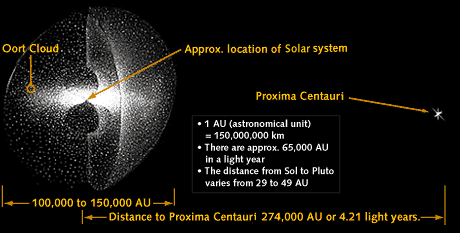
Image: The Oort Cloud in relation to the Solar System. Credit: UC-Berkeley/Comet’s Tale Development Team.
Whether we’re settlers or voyagers (and I suspect we’ll be both), we’ll learn all along the way from the experience of adapting to space. Ben Finney and Eric Jones put it this way in their paper “Fastships and Nomads” (reference at the end of yesterday’s post):
If interstellar settlement happens at all, it will come after our descendants have learned to maintain self-sufficient communities detached from Earth’s nurturing biosphere, learned to tap the knowledge and skill potential of advanced computers, learned to efficiently harness the energy that flows out of the Sun, and even learned to extract useful energy from the fusion of atoms. We are on the verge of achieving all these things. With sufficient skill and patience we will attain the stars.
Of course, we have been on the ‘verge’ for a long time when it comes to fusion. But taking the long view of human expansion and looking not just decades but centuries ahead, these words resonate.
Finding the Energy
Whichever scenario strikes your fancy, the energy conundrum is still huge. Yesterday I talked about Finney and Jones’ ideas of concentrating starlight through vast mirrors the size of the continental United States. Terra picks up on this to describe colonists living in O’Neill cylinders, each housing a band of outer system stalwarts who would tend a mirror farm stretching across 30,000 kilometers of space. Maybe ‘tending’ is the wrong word, though — robotic systems would surely do the heavy lifting with substantial human oversight. From Terra’s paper:
The primary sector of the economy — the exploitation of natural resources — is likely to be small and almost completely automated. Human involvement will be minimal. The primary sector will consist of two basic activities: energy production and the harvesting of cometary resources. Once the appropriate systems are established, both will be relatively simple activities.
The secondary sector — the transformation of the natural resources — will include refining and processing the raw cometary feedstock, manufacturing, construction and assembly operations, agriculture and food production, and recycling. Again, many of these activities will be highly automated, but closer human supervision will be necessary to tailor these activities to the current needs of the community.
Terra goes on to cite a third sector where most of the human skill set will go to work. Here he’s talking about support services that maintain the life support systems and needed repairs to the colony world. Information processing, education, administration, and eventually business and commerce between settlements will command the attention. The latter, keeping colonists in contact with other colonies, has also been proposed in various starship scenarios over the course of long voyages, with multiple ships accompanying each other on the journey.
Both Terra and Finney and Jones, of course, are talking about full time colonies rather than crews in transit. Their mirror farms are themselves components of even larger arrays, spread out perhaps 200,000 kilometers from the cometary nucleus. Growing the community would mean creating comet clusters by moving new comets into range, which would allow populations up to 100,000 or so to exist, though spread out widely through the cluster. With perhaps a light-day of separation between communities living in such clusters, the colonists would be in constant electromagnetic communication with other settlements scattered throughout the inner and outer Oort.
The Fusion Alternative
As wondrous a science fictional setting as this provides (and vast mirrors inevitably call to mind the continent-sized sails of Cordwainer Smith’s “The Lady Who Sailed the Soul”), I’d like to think there are more practical ways to produce the needed energy. But what? Fission doesn’t fly out here because the heavy elements are found in only minute amounts. Remember, we’re not talking about a colony world that is sustained by regular supplies from the inner system. We have to exploit local resources, and that takes us to the deuterium available in comets.
If fusion can be mastered, we have changed the game. In his book Entering Space: Creating a Spacefaring Civilization (Tarcher, 1999), Robert Zubrin points to the progress in both robotics and artificial intelligence that will be needed to sustain widely scattered colonies, adding that previous experience settling the asteroid belt may teach us many lessons. But he doesn’t like the starlight mirror idea one bit:
While some have suggested concentrating starlight, it doesn’t really make sense. To get a single megawatt of power, the mirror would have to be the size of the continental United States. The only viable alternative based on currently known physics is fusion. In the Kuiper Belt, it might be possible to get helium-3 shipped out from mining operations around Neptune. Oort Cloud settlements would be too far out to obtain much from the solar system, though deuterium should be available in all iceteroids, so perhaps the colonists might choose to build reactors based on that fuel alone. However, helium can exist in the liquid phase below 5 K (-268 degrees C), which is the environmental temperature at about 3000 AU. It is therefore not impossible that liquid helium could exist within Oort Cloud objects beyond that distance.
But even if we can make fusion work — and I’m assuming that a civilization that can move large payloads to the Oort Cloud is one that probably has — our isolated communities still have an energy conundrum. They’ve got a couple of centuries worth of fusion fuel in the comet cluster they’ve cultivated, but it’s still a non-renewable resource. That’s going to mean tight rationing of fusion fuels even if the technology is available, unless somehow proton fusion can be mastered. Maybe an Oort Cloud settlement of any size would have to have Finney and Jones’ mirrors after all, constructing them as the only renewable solution for succeeding generations.
Zubrin thinks wanderlust and the pioneer spirit will drive some humans outward to test out such scenarios. After all, the great bulk of human society will remain in the inner system where the warmth is, and its possible that the growing centralization and homogeneity of culture here over the course of centuries would incline the more independent-minded to emigrate. O’Neill cylinders, asteroids and comets may be the ideal home for dissident groups trying social experiments and pushing the envelope on what a human society can become. “Why live on a planet whose social laws and possibilities were defined by generations long dead, when you can be a pioneer and help to shape a new world according to reason as you see it?” Zubrin asks.
But there may be other scenarios that would force us into the Oort Cloud. Tomorrow I’ll look at a couple of possibilities that could make the outer system our stepping stone to the nearest stars.






March 26, 2013
Into the Oort Cloud: A Cometary Civilization?
Jules Verne once had the notion of a comet grazing the Earth and carrying off a number of astounded people, whose adventures comprise the plot of the 1877 novel Off on a Comet. It’s a great yarn that was chosen by Hugo Gernsback to be reprinted as a serial in the first issues of his new magazine Amazing Stories back in 1926, but with a diameter of 2300 kilometers, Verne’s comet was much larger than anything we’ve actually observed. Comets tend to be small but they make up for it in volume, with an estimated 100 billion to several trillion thought to exist in the Oort Cloud. All that adds up to a total mass of several times the Earth’s.
Of course, coming up with mass estimates is, as with so much else about the Oort Cloud, a tricky business. Paul R. Weissman noted a probable error of about one order of magnitude when he produced the above estimate in 1983. What we are safe in saying is something that has caught Freeman Dyson’s attention: While most of the mass and volume in the galaxy is comprised of stars and planets, most of the area actually belongs to asteroids and comets. There’s a lot of real estate out there, and we’ll want to take advantage of it as we move into the outer Solar System and beyond.
Comets and Resources
Embedded with rock, dust and organic molecules, comets are composed of water ice as well as frozen gases like methane, carbon dioxide, carbon monoxide, ammonia and an assortment of compounds containing nitrogen, oxygen and sulfur. Porous and undifferentiated, these bodies are malleable enough to make them interesting from the standpoint of resource extraction. Richard P. Terra wrote about the possibilities in a 1991 article published in Analog:
This light fragile structure means that the resources present in the comet nuclei will be readily accessible to any human settlers. The porous mixture of dust and ice would offer little mechanical resistance, and the two components could easily be separated by the application of heat. Volatiles could be further refined through fractional distillation while the dust, which has a high content of iron and other ferrous metals, could easily be manipulated with magnetic fields.
Put a human infrastructure out in the realm of the comets, in other words, and resource extraction should be a workable proposition. Terra talks about colonies operating in the Oort Cloud but we can also consider it, as he does, a proving ground for even deeper space technologies aimed at crossing the gulf between the stars. Either way, as permanent settlements or as way stations offering resources on millennial journeys, comets should be plentiful given that the Oort Cloud may extend half the distance to Alpha Centauri. Terra goes on:
Little additional crushing or other mechanical processing of the dust would be necessary, and its fine, loose-grained structure would make it ideal for subsequent chemical processing and refining. Comet nuclei thus represent a vast reservoir of easily accessible materials: water, carbon dioxide, ammonia, methane, and a variety of metals and complex organics.
Energy by Starlight
Given that comets probably formed on the outer edges of the solar nebula, their early orbits would have been more or less in the same plane as the rest of the young system, but gravitational interactions with passing stars would have randomized their orbital inclinations, eventually producing a sphere of the kind Jan Oort first postulated back in 1950. Much of this is speculative, because we have little observational evidence to go on, but the major part of the cometary shell probably extends from 40,000 to 60,000 AU, while a projected inner Oort population extending from just beyond the Kuiper Belt out to 10,000 AU may have cometary orbits more or less in the plane of the ecliptic. Out past 10,000 AU the separation between comets is wide, perhaps about 20 AU, meaning that any communities that form out here will be incredibly isolated.
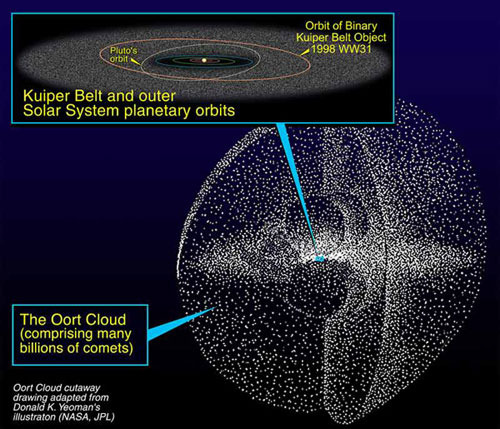
Image: An artist’s rendering of the Kuiper Belt and Oort Cloud. Credit: NASA/Donald K. Yeomans.
Whether humans can exploit cometary resources this far from home will depend on whether or not they can find sources of energy. In a paper called “Fastships and Nomads,” presented at the Conference on Interstellar Migration held at Los Alamos in 1983, Eric Jones and Ben Finney give a nod to non-renewable energy sources like deuterium, given that heavy elements like uranium will be hard to come by. Indeed, a typical comet, in Richard Terra’s figures, holds between 50,000 and 100,000 metric tons of deuterium, enough to power early settlement and mining.
But over the long haul, Jones and Finney are interested in keeping colonies alive through renewable resources, and that means starlight. The researchers talk about building vast mirrors using aluminum from comets, with each 1 MW mirror about the size of the continental United States. Now here’s a science fiction setting with punch, as the two describe it:
Although the mirrors would be tended by autonomous maintenance robots, the nomads would have to live nearby in case something went wrong… Although we could imagine that the several hundred people who could be supported by the resources of a single comet might live in a single habitat, the mirrors supporting that community would be spread across about 150,000 km. Trouble with a mirror or robot on the periphery of the mirror array would mean a long trip, several hours at least. It would make more sense if the community were dispersed in smaller groups so that trouble could be reached in a shorter time. There are also social reasons for expecting the nomad communities to be divided into smaller co-living groups.
Jones and Finney go on to point out that humans tend to work best in groups of about a dozen adults, whether in the form of hunter/gatherer bands, army platoons, bridge clubs or political cells. This observation of behavior leads them to speculate that bands of about 25 men, women and children would live together in a large habitat — think again of an O’Neill cylinder — built out of cometary materials, from which they would tend a mirror farm with the help of robots and computers. Each small group would tend a mirror farm perhaps 30,000 kilometers across.
The picture widens beyond this to include the need for larger communities that would occasionally come together, helping to avoid the genetic dangers of inbreeding and providing a larger social environment. Thus we might have about 500 individuals in clusters of 20 cometary bands which would stay in contact and periodically meet. Jones and Finney consider the band-tribe structure to be the smallest grouping that seems practical for any human community. Who would such a community attract — outcasts, dissidents, adventurers? And how would Oort Cloud settlers react to the possibility of going further still, to another star?
More on this tomorrow. For now, the Terra article is “Islands in the Sky: Human Exploration and Settlement of the Oort Cloud,” Analog June, 1991, pp. 68-85. The Jones and Finney paper is “Fastships and Nomads,” in Finney and Jones (eds)., Interstellar Migration and the Human Experience, University of California Press (1985), pp. 88-103.






March 25, 2013
The British Interplanetary Society at 80 Years: Part II
by Kelvin F. Long
The chief editor of the Journal of the British Interplanetary Society here offers part II of his article on the Society’s history. If there is one BIS project that captures the imagination above all others, it’s surely Project Daedalus, the ambitious attempt to design a spacecraft capable of reaching a nearby star within 50 years. But the motivations for Daedalus were wide-ranging and the conclusions of the study may surprise you. The success of the design effort showed us what was possible with the technology of its time, while subsequent studies like Project Icarus upgrade the vessel and take us that much closer to what may one day be a working craft.
Les Shepherd took things to new heights with the publication of his seminal 1952 paper “Interstellar Flight”. This was the first paper ever to properly address the physics and engineering issues associated with sending a probe to another star and it is what I regard as the beginning of interstellar studies as a subject. This brings us to one of the seminal studies of the society, Project Daedalus. Speaking to people about the Project Daedalus study, it is clear that many today don’t fully appreciate the real motivation behind it, which was the Fermi Paradox. This is the apparent contradiction between our theoretical expectations for intelligent life in the universe and our lack of observational evidence.
One of the ways to begin to address this is just to ask if it is even possible to travel between the stars (just like the BIS had earlier asked if it was possible to conceive of a machine to travel to the Moon). So the Daedalus team spent five years (mostly in pubs) designing the 50,000 ton unmanned probe capable of reaching 12% of the speed of light. Their guiding principle was to find a balance between being sufficiently bold and being sufficiently credible. This meant that the design had current technology (1970s) and extrapolated technology (few decades hence).
The approach naturally led to design contradictions (i.e. vacuum tubes next to an AI computer) and was the main limitation on the fidelity of the design integration. But most would agree the team did a pretty good job. As Centauri Dreams readers are familiar with Daedalus by now, I won’t go over the design itself, except to say that it would be a 450 ton flyby probe that was delivered to the Barnard’s Star system, 5.9 light years away after a journey lasting around half a century. At the end of the study the team concluded that if at the outset of the space age we can conceive of a machine such as Daedalus where interstellar flight appeared to be possible, then it is likely that in the coming centuries we could derive a more credible and practical design.
On the basis of this, they concluded that interstellar travel was therefore feasible, and so the explanation for the Fermi Paradox may lay in some other solution (i.e. the prevalence of biological life). But Daedalus was the first study to prove that interstellar flight was possible.
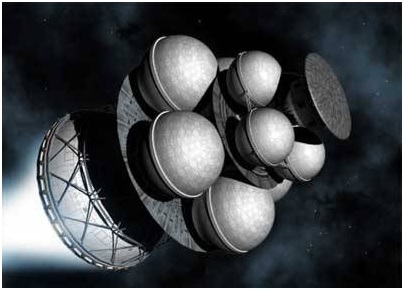
Image: The BIS Project Daedalus, a modern illustration. Credit: Adrian Mann.
Anyone who studies aerospace engineering knows that a vehicle design goes through three levels of iteration. First is the concept design phase, which addresses whether it will work, what it looks like, what requirements drive the design, what trade-offs should be considered and what mass it should have — and if necessary how much it would cost. The next level is the preliminary design phase, which freezes the configuration, develops any vehicle sizing, creates the analytical basis for the design and moves into experimental demonstrations if appropriate. The final level is the detailed design phase, which identifies the individual pieces to be constructed. This includes any tools required. It involves any critical design tests of the structure and finalizes the vehicle configuration layout and performance specification.
Along the way, there is a process of integrating the various systems and subsystems, today couched in the language of systems engineering. In my opinion the Daedalus was an early preliminary vehicle design for a starship. The team defined all of the major systems and most of the subsystems. Full integration was not possible due to the nature of the technological extrapolation. But the vehicle configuration layout, performance specification and mission profile were defined in full where practical to do so.
During my own reading of interstellar concepts, I have come across solar sail-driven methods, laser beaming, microwave beaming, fusion, antimatter and exotic concepts, to name a few. All of these studies have been concept papers, however, or proposal submissions, or case study analyses – they do not constitute designs. I argue that at best they are concepts and for most of them even that term is not fully justified due to errors in the calculations or the gaping areas of engineering or physics not addressed. Daedalus is the only one that can be claimed to be a “starship design” in my view. The only other vehicle that comes close to it is the Project Orion design from the 1950s and 1960s. Orion certainly was a preliminary design, but it was calculated for an interplanetary mission only. Then there were the worldship studies from the 1980s by Alan Bond and Anthony Martin, but these did not go into the sub-system level of the internal architecture. Daedalus was first, and Daedalus remains the only one
On a recent visit to NASA Marshall Space Flight Center, NASA Glenn Research Center and the Tennessee Valley Interstellar Workshop, I challenged people to refute my controversial (and deliberately provocative) claim that Daedalus is the only starship design in history. NASA appeared to agree with me. This is an astonishing revelation and I find it intriguing that people are prepared to pronounce interstellar flight impossible when we have only attempted one such design in history. More feasibility studies are clearly required before we can have a clear picture of what the impossibilities or otherwise are.
There are three profound implications that come out of the Daedalus study which I think are worth highlighting again because they are so important:
That interstellar travel appears to be entirely feasible in theory and so in the future will likely be feasible in practice.
That because interstellar travel is feasible, the absence of any observation of intelligent life in the universe suggests we must seek alternative explanations.
That Daedalus was the first and so far only starship design in history and remains so to this day (until the completion of the Project Icarus study anyway).
In the light of history and developments in astronomy, I suppose an important addendum should now be added to the Daedalus study, which is that a flyby is probably not the way to send a probe to another star. This was the view of the Project Icarus team early on, which is why we made deceleration an engineering requirement for the mission. We live in an age where exoplanets are discovered almost weekly, orbiting around other star systems. In the future we should be able to fully characterise those planets, including their stellar atmospheres, using Earth orbiting or lunar based deep space observatories, so the benefits of flyby must be justified from both a performance and cost basis. In order to add value to an interstellar mission, it is more beneficial to send a probe that can release atmosphere penetrators and planetary landers into the local system, accessing the surface that deep space platforms from Earth cannot reach.
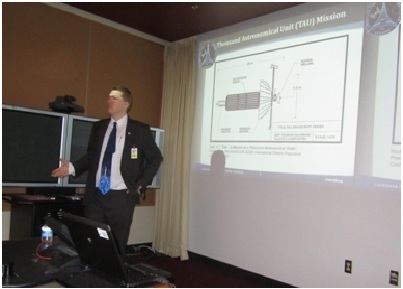
Image: Kelvin F.Long lecturing at NASA Marshall Spaceflight Center, February 2013.
Numerous other BIS projects have been in play, the earliest being development of a coelosat in the 1930s, a device capable of effecting navigation by the stars. Ken Gatland invented the idea of the MOUSE launcher from 1948-1950. The lunar lander underwent various developments by Ralph Smith from 1947-1952. Smith also developed the concept of a space station with Harry Ross from 1948-1958. He also designed a manned orbital winged rocket in 1950. Les Shepherd and Val Cleaver wrote some of the first pioneering papers on atomic rockets from 1948-1949. Arthur C Clarke was also busy during this period, designing his electromagnetic lunar launch system in 1950 and the atomic interplanetary spaceship in 1952. His spaceship design was shown in several popular space books by himself, Gatland and others around that time and it has a striking resemblance to the Ares, the vehicle that features in Clarke’s book The Sands of Mars and also the Discovery I which is the design featured in 2001: A Space Odyssey.
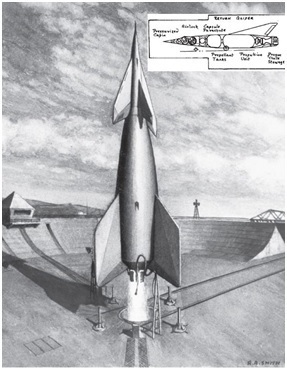
Members of the BIS have also been involved in various spin-off projects such as the 1980s HOrizontal Take-off and Landing (HOTOL) project initiated by people like Bob Parkinson at British Aerospace and Alan Bond, then at Rolls Royce. Bond went on to found Reaction Engines Ltd and to develop the groundbreaking Sabre engine, the critical technology required in order to make a vehicle like Skylon (the successor design to HOTOL) technically credible. Charles Cockell launched Project Boreas in 2001, an initiative to design a human habitat at the geographic Martian north pole. The project featured luminaries such as the astronomer Ian Crawford and the science and science fiction author Stephen Baxter, all dedicated members of the society. Other big names have been members of the society throughout its history, including Bob Zubrin, the guy that radically changed our thinking on how to do Mars missions more than anyone. In the 1980s he was regularly communicating with the BIS planetary engineering (terraforming) expert Martyn Fogg, who was then arguably the world authority on the subject.
Image: The BIS Winged Orbital Rocket. Credit: BIS.
I mustn’t forget Olaf Stapledon of course. I am unsure if he ever joined as a member but his famous 1948 lecture on “Interplanetary Man” at the invitation of Clarke was one of those world events that anyone would have wished to attend. I wasn’t born then but was fortunate to meet Stapledon’s grandson Jason Shenai last year. Jason came to the BIS to attend the “Starmaker” symposium which the Technical Committee had organised.
The above are just some examples of major projects the society has pioneered as feasibility studies in the early years, all of which (except for the interstellar probe and SSTO) came to fruition, showing that the society played a vital role in engineering the future. This is what Arthur C.Clarke refers to as “creating a self-fulfilling prophecy,” and this can be achieved by the adoption of positive and optimistic advocacy.
My own entry into the BIS (and indeed the space/interstellar community) was the organisation of the Warp Drive conference in 2007. Speakers came from across the world to London to discuss the developments since Miguel Alcubierre’s seminal 1994 paper. This is where I first met Claudio Maccone and Richard Obousy. It was with Richard’s assistance that we both went on to found Project Icarus, with the goal of catalysing the interstellar community. Those were exciting days. When we look around us at the many interstellar related organisations working on the goal of starflight, we can be proud of our efforts and know that we played some role. Project Icarus was always intended as part designer training exercise more than anything, recognising that there was a lack of design capability to actually work on starships at the time.
The other purpose of the project was to inspire people young and old to believe in the dream of star travel once again. Project Icarus is still on-going as a joint British Interplanetary Society project with the US non-profit Icarus Interstellar, who now manages the project until its completion. Icarus Interstellar have gone on to found many other design projects, taking our original ambitions to a new and hopeful level and I’m proud to have played a role in its foundation. I have also now moved on to found the pending Institute for Interstellar Studies. We and all the interstellar organizations are building the vital industry needed to make interstellar happen at some point in our not too distant future.
On the 13th October 2013 the British Interplanetary Society will be 80 years old. When I consider the achievements of the BIS throughout its history, I am also forced to consider its function. The society is clearly not a science fiction society, but it is also clearly not a commercial space organisation. As a registered charity, I find that its function is in fact unique, in that it exists between both of these worlds. It stands in the metaphorical corridor between “imagination” and “reality” and this is in fact its motto: “from imagination to reality”. People have ideas, concepts, designs, they bring to the BIS and the various mechanisms (lectures, publications, symposia) will help to catalyse those ideas and then to bring them to the attention of wider industry, government and academia.
Nothing exemplifies this more than the example of the BIS Lunar Lander. One wonders whether Daedalus and the Project Icarus study are playing the same role today but for interstellar flight. We also have a role to point the way, to act as a compass direction for future achievements. To help to convince industry, government, academia, the public and the media that something is possible, where the data may have previously suggested it was not. In this way, we encourage innovations and breakthroughs which can lead to new technologies, industries or processes, and thereby greater achievements in the exploration of space.
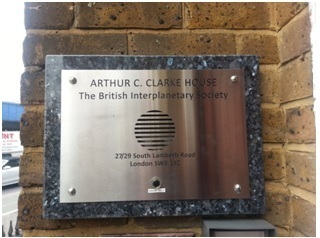
The HQ building in London is now officially called “Arthur C.Clarke House”, and Clarke twice served as President of the society (then called Chairman) in the years 1946-1947 and 1951-1953. He remains our most inspirational member and we are very proud to carry on with his legacy. It may surprise many to know that although the BIS is the oldest space organisation in the world, it has also been struggling to survive through challenging financial times. Despite this it has continued to serve a vital role for the community at large. The technical publication JBIS, for example, is famous for the publication of its “red cover” issues on interstellar studies from 1974–1991 (we have recently been issuing new red cover volumes), and it has remained the torch holder of the interstellar vision through the decades.
Image: The BIS door bell. Credit: BIS.
Where else would all of those creative talents have found a home for their pioneering and speculative publications on starship design or the Search For Extraterrestrial Intelligence (SETI)? However, don’t despair, as things are looking up with the election of an inspirational new President, Alistair Scott, who has a charismatic military-based leadership style, from his experience as an Army officer. He originally studied aeronautical engineering at university and after several exciting positions in industry he settled for many years at the satellite company Astrium. Scott is applying this huge experience to driving the recovery of the society, literally running the committees like they were platoons within a regiment. Yet he is as down to Earth and charming as they come and a complete gentleman, showing respect and warmth for all people no matter their background or rank. He is supported by his loyal team, including Vice Presidents Mark Hempsell (Reaction Engines Future Programs Director), Chris Welch (International Space University Professor) and Suszann Parry, the Executive Secretary.
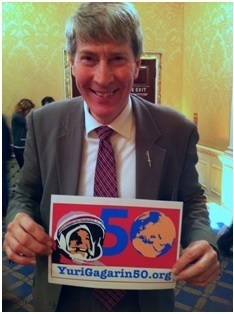
The society has many new and exciting projects coming online under the supervision of Technical Committee Chairman Richard Osborne, a pioneer of amateur rocketry himself. The BIS is participating in Project KickSat, which is an initiative by Zac Manchester out of Cornell University in the US to place a fleet of ChipSats or Sprites into Low Earth Orbit sometime this year. The BIS members put several thousand pounds into the project, which is now managed with enthusiasm by Andrew Vaudin. The society is also launching Project 2033 (managed by myself), a competition to imagine the future state of space exploration at the society’s centennial anniversary. Sir Arthur C Clarke is famous for his ability to see into the future and predict technology trends. We are hoping to find the next visionary and to see twenty years from now who gets it right. We have recently launched Project STARDROP, which stands for Solar Thermal Amplified Radiation Dynamic Relay of Orbiting Power, which aims to design a 10 GW solar collector power system to run an L5 space colony. This is now being managed by Ian Stotesbury. The past projects of the BIS are outstanding but we are looking towards the next horizon in space.
Image: The BIS President Major Alistair Scott. Credit: BIS.
Things seem to be changing in Britain for the better with government attitudes towards space exploration being much more positive. We now have our own United Kingdom Space Agency (UKSA), our own European Astronaut Tim Peak (Britain’s first official astronaut), and as if things could get any better, it was recently announce that a UK industry team in cooperation with UKSA is investigating whether Britain should have its own spaceport…and launch vehicle (yes, you read that right). The company Reaction Engines already has an answer to this of course, with its innovative Single Stage To Orbit (SSTO) spaceplane design. The company recently announced critical breakthroughs relating to the pre-cooler technology which has previously prevented similar concepts becoming reality.
We may be the oldest space organisation in the world, but we are also a thriving organisation, making changes to ourselves so as to better serve the modern technological world. We would love for new people to come and join us and be a part of this great society, with its global outreach and impact. We are particularly looking for members in the US or elsewhere to start BIS branches. The history above proves that the BIS does engineer the future. If this is attractive to you too, and you are interested in being a catalyst to our own determined self-fulfilling prophecy, then you will find a home with the BIS. We welcome new members who want to help take imagination to reality. Be unique, and join the British Interplanetary Society, because it’s where the future is made. And the next time you are in London, be sure to pay us a visit.
Finally, I want to end this article with a donations appeal. The BIS is a registered charity and we are all volunteers, including me, yet I manage to run the journal and keep the papers moving. Our financial demands are high and this has impeded our ability to meet the mission. If you believe that the British Interplanetary Society’s role in astronautics has been and continues to be important, then please consider making a donation and we will carry on doing it. Ad Astra.
==
Donations to the BIS can be made here:
http://www.bis-space.com/products-page/donation/
The main BIS web site is located here: www.bis-space.com
The Technical JBIS web site is located here: http://www.jbis.org.uk/
The information on past BIS projects was partly borrowed from the BIS book Interplanetary by Bob Parkinson and incorporates edited information from articles from the August and September 1967 issues of the BIS magazine Spaceflight. The book is available for purchase here: http://www.bis-space.com/products-page/books/






Paul Gilster's Blog
- Paul Gilster's profile
- 7 followers



